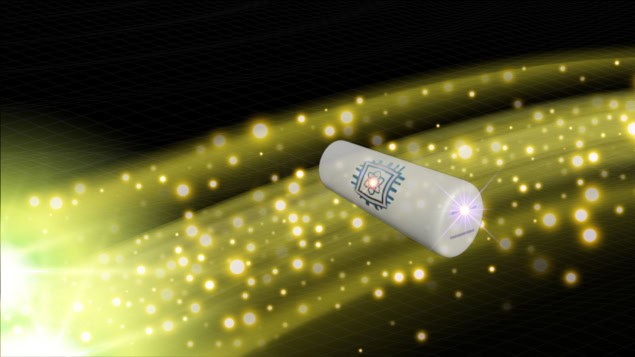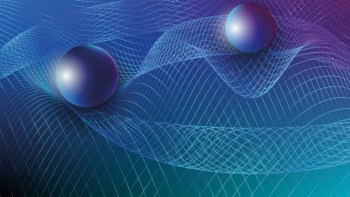
According to quantum mechanics, our universe is like a Lego set. All matter particles, as well as particles such as light that act as messengers between them, come in discrete blocks of energy. By rearranging these blocks, it is possible to build everything we observe around us.
Well, almost everything. Gravity, a crucial piece of the universe, is missing from the quantum Lego set. But while there is still no quantum theory of gravity, the challenge of detecting its signatures now looks a little more manageable thanks to a proposed experiment that takes inspiration from the photoelectric effect, which Albert Einstein used to prove the quantum nature of light more than a century ago.
History revisited
Quantum mechanics and general relativity each, independently, provide accurate descriptions of our universe – but only at short and long distances, respectively. Bridging the two is one of the deepest problems facing physics, with tentative theories approaching it from different perspectives.
However, all efforts of describing a quantum theory of gravity agree on one thing: if gravity is quantum, then it, too, must have a particle that carries its force in discrete packages, just as other forces do.
In the latest study, which is described in Nature Communications, Germain Tobar and Sreenath K Manikandan of Sweden’s Stockholm University, working with Thomas Beitel and Igor Pikovski of the Stevens Institute of Technology, US, propose a new experiment that could show that gravity does indeed come in these discrete packages, which are known as gravitons.
The principle behind their experiment parallels that of the photoelectric effect, in which light shining on a material causes it to emit discrete packets of energy, one particle at a time, rather than in a continuous spectrum. Similarly, the Stockholm-Stevens team proposes using massive resonant bars that have been cooled and tuned to vibrate if they absorb a graviton from an incoming gravitational wave. When this happens, the column’s quantum state would undergo a transition that can be detected by a quantum sensor.
“We’re playing the same game as photoelectric effect, except instead of photons – quanta of light – energy is exchanged between a graviton and the resonant bar in discrete steps,” Pikovski explains.
“Still hard, but not as hard as we thought”
While the idea of using resonant bars to detect gravitational waves dates back to the 1960s, the possibility of using it to detect quantum transitions is new. “We realized if you change perspectives and instead of measuring change in position, you measure change in energy in the quantum state, you can learn more,” Pikovski says.
A key driver of this perspective shift is the Laser Interferometer Gravitational-wave Observatory, or LIGO, which detects gravitational waves by measuring tiny deviations in the length of the interferometer’s arms as the waves pass through them. Thanks to LIGO, Pikovski says, “We not only know when gravitational waves are detected but also [their] properties such as frequency.”

In their study, Pikovski and colleagues used LIGO’s repository of gravitational-wave data to narrow down the frequency and energy range of typical gravitational waves. This allowed them to calculate the type of resonant bar required to detect gravitons. LIGO could also help them cross-correlate any signals they detect.
“When these three ingredients—resonant bar as a macroscopic quantum detector, detecting quantum transitions using quantum sensors and cross-correlating detection with LIGO— are taken altogether, it turns out detecting a graviton is still hard but not as hard as we thought,” Pikovski says.
Within reach, theoretically
For most known gravitational wave events, the Stockholm-Stevens scientists say that the number of gravitons their proposed device could detect is small. However, for neutron star-neutron star collisions, a quantum transition in reasonably-sized resonant bars could be detected for one in every three collisions, they say.
Carlo Rovelli, a theorist at the University of Aix-Marseille, France who was not involved in the study, agrees that “the goal of quantum gravity observations seem within reach”. He adds that the work “shows that the arguments claiming that it should be impossible to find evidence for single-graviton exchange were wrong”.
Frank Wilczek, a theorist at the Massachusetts Institute of Technology (MIT), US who was also not involved in the study, is similarly positive. For a consistent theory that respects quantum mechanics and general relativity, he says, “it can be interpreted that this experiment would prove the existence of gravitons and that the gravitational field is quantized”.
So when are we going to start detecting?
On paper, the experiment shows promise. But actually building a massive graviton detector with measurable quantum transitions will be anything but easy.
Part of the reason for this is that a typical gravitational wave shower can consist of approximately zillions of gravitons. Just as the pattern of individual raindrops can be heard as they fall on a tin roof, carefully prepared resonant bars should, in principle, be able to detect individual incoming gravitons within these gravitational wave showers.
But for this to happen, the bars must be protected from noise and cooled down to their least energetic state. Otherwise, such tiny energy changes may be impossible to observe.

Motions of the planets put new limit on graviton mass
Vivishek Sudhir, an expert in quantum measurements at MIT who was not part of the research team, describes it as “an enormous practical challenge still, one that we do not currently have the technology for”.
Similarly, quantum sensing has been achieved in resonators, but only at much smaller masses than the tens of kilograms or more required to detect gravitons. The team is, however, working on a potential solution: Tobar, a PhD student at Stockholm and the study’s lead author, is devising a version of the experiment that would send the signal from the bars to smaller masses using transducers – in effect, meeting the quantum sensing challenge in the middle. “It’s not something you can do today, but I would guess we can achieve it within a decade or two,” Pikovski says.
Sudhir agrees that quantum measurements and experiments are rapidly progressing. “Keep in mind that only 15 years ago, nobody imagined that tangibly macroscopic systems would even be prepared in quantum states,” he says. “Now, we can do that.”



